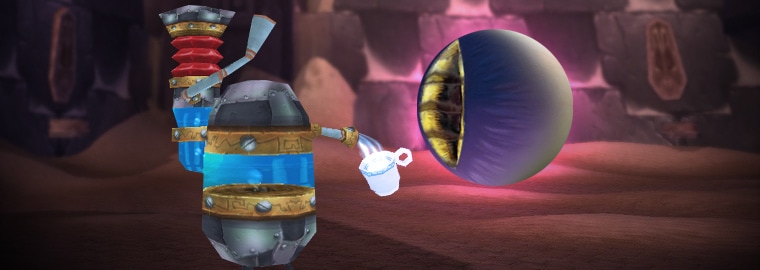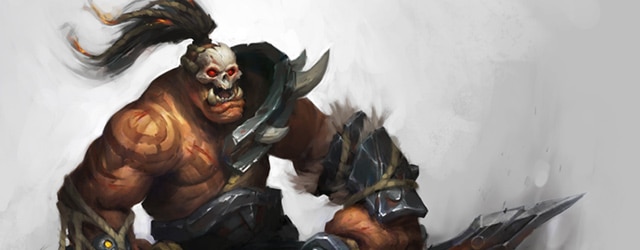Over the course of WoW’s nearly 10-year history, raiding has probably undergone more iteration and change than any other game system. To put the upcoming Warlords of Draenor raid changes into proper context, this three-part blog series will attempt to retrace the twists and turns of our raid design philosophy from Molten Core through Siege of Orgrimmar.
In this final entry, Lead Game Designer Ion “Watcher” Hazzikostas wraps things up by taking a look at the raiding philosophy and design changes coming in Warlords of Draenor (Warlords).
Warlords of Draenor (2014)
As we announced at BlizzCon, we’re excited about the opportunity to extend our Flexible Raid tech to address some of the long-standing problems we’ve been grappling with as a design team for over 5 years now. Here’s a quick breakdown of how the new system works: We’re relabeling Flexible Raid mode Normal, and it will serve as the new baseline point of entry to organized raiding. We’re also combining the current 10-player and 25-player Normal modes into a single Heroic difficulty. Finally, we’re consolidating 10-player and 25-player Heroic into a new fixed-size 20-player Mythic difficulty.
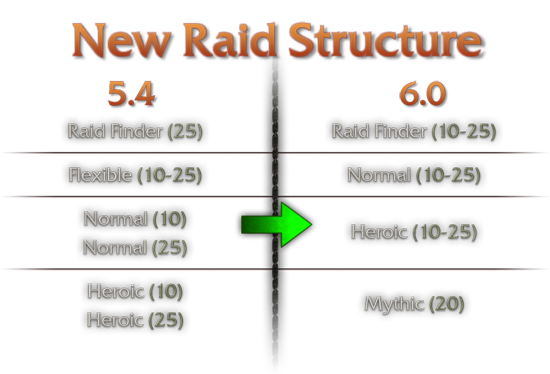
This system will allow the vast majority of players to raid with a wide variety of possible raid sizes, and reap the benefits of that structure. One of the major upsides of a 13-player raid is that you don’t have to worry about canceling if one or two people aren’t able to make it; you also don’t have to worry about asking someone to sit out if everyone shows up. This, in turn, means that raiding in an organized group is possible without the same feeling of obligation, and that such groups will be much more resilient in practice.
While we’ve made significant strides in tuning 10-player and 25-player Normal modes to be comparable in difficulty over the course of Mists of Pandaria (Mists), precise 10 vs. 25 Heroic tuning has continued to be a major challenge, especially on important fights such as Lei Shen (easier with 10) and Garrosh (easier with 25). Consolidating to a single raid size for Mythic will allow us to focus on delivering the best possible experience for our competitive hardcore raiders, while the flexible nature of Normal and Heroic mode provides an avenue for smaller groups to organically grow and continue raiding if they want to give Mythic a try.
Group Finder
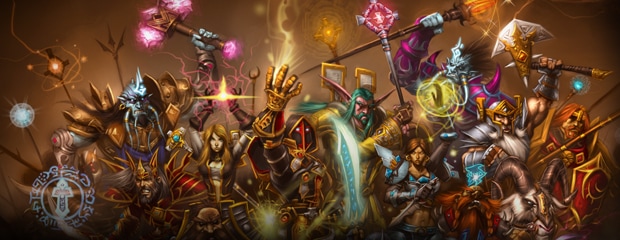
Another central innovation in Warlords is our Group Finder feature, which will allow players to easily form and search for raid groups (among other activities) with players from their entire region. While this series of blogs has mostly focused on pre-existing social structures, pick-up groups continue to be tremendously important. Chance meetings in such groups have formed the basis for many a friendship, and recurring weekly pickup groups have given rise to more than a few guilds over the years. For players who want to take the next step beyond Raid Finder, or who want to find a weekend run for their alt, or who just need a last-minute tenth member for their raid, Group Finder will make that process easier than ever before.
Raid Finder
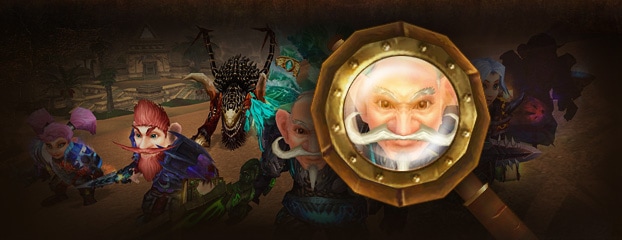
Raid Finder still has an important place within the new Warlords raid structure. Many players cannot or simply do not want to commit to a fixed group. And no matter how convenient we make organized raiding through Group Finder, it’ll never be something you can jump in and do for 45 minutes during your downtime on a busy day, the way you might do a Raid Finder wing.
However, we’ve also learned other lessons from our experience with Raid Finder over the past two and a half years. Raiding a single zone with a guild or group of friends can stay engaging for months, and one of the core reasons for that is the pacing of progression through a zone. A raid group might start out learning a new boss or two each week; that pace slows as the raid reaches the later bosses near the end of a zone, and more time each week is spent re-clearing “farm content” to gear up further. This keeps the experience varied, and even if you don’t get the specific loot you were hoping for in a given week, you’re seeing your friends and guildmates progress and get stronger, and you’re feeling the impact of those upgrades as you kill bosses faster and faster.
Raid Finder offers none of that. Your ninth clear of the Underhold section of Siege of Orgrimmar is likely no faster than your second (and might even be slower); you aren’t experiencing anything new or different. So how can we make Raid Finder a more compelling and enjoyable experience? A decent first step is to make it significantly more generous than it has been in the past, nearly doubling the rate of reward to better match the overall pacing of the content.
Our intent is for Raid Finder to allow players to experience our raid content, see the conclusion of major storylines, and witness the epic environments that our artists create without needing to commit to an organized raid group. We’d like to focus on that purity of purpose, and minimize the elements that have made guild raiders feel like they needed to do Raid Finder each week as part of their core progression. Accordingly, while loot will be awarded more frequently, Raid Finder in Warlords will have different loot tables than the Normal, Heroic, or Mythic versions of the raids, along with different item art. The gear will fall in between dungeon loot and Normal mode raid loot in terms of power, as it does today, but without the set bonuses and specific trinkets that tend to make raiders feel like they need to run Raid Finder alongside their weekly guild raids today.
After a player gets quickly geared up through Raid Finder and starts thinking about venturing into Normal mode for better rewards, their Raid Finder loot and combat experience should prepare them to take that next step—and Group Finder will make the process easier than ever before.
Raid Lockouts
In Warlords, each raid difficulty will have its own weekly lockout. We gave careful consideration to how the lockout system should work, and which difficulties (if any) would share lockouts. Having seen how Flex works today, it’s clear there are many benefits to having our raid difficulties on separate lockouts: Players might currently raid Normal or Heroic Siege of Orgrimmar with their guilds on a set schedule, but then join real-life friends on another server for weekend Flex runs and a chance to grab some off-spec loot. Players who are regularly clearing Normal, let alone Heroic, Siege of Orgrimmar quickly find that they don’t need much main-spec loot from Flex. Most players who are doing Siege in multiple difficulties each week are doing so with different social groups, and we’d like to preserve players’ freedom to do so.
As for Heroic and Mythic, having those difficulties share a lockout would present a number of technical as well as logistical challenges: Heroic is a flexible-size loot-based lockout; Mythic is a fixed-size boss-based lockout, limited to a single realm, with a static ID. The two simply aren’t congruent. Having these on a separate lockout also simplifies some things for high-end guilds that are trying to manage progress on a limited schedule, and currently have to carefully budget enough time at the end of each week to re-kill remaining bosses on Normal difficulty for loot. In Warlords, those groups will be able to frontload their farming for the week and then work on Mythic progression for the rest of the week without worry.
Reflecting on the “Trial of the Crusader problem” in Patch 3.2, much of the issue there stemmed from the way Emblems worked at the time. Badges obtained from raid bosses and dungeons were necessary just to buy set pieces, and so guilds felt obligated to keep clearing something like 10-player Normal Trial of the Crusader, even if they needed none of the loot, just for the extra Emblems. In Warlords, we are scaling back Valor, along with the incentive to cap Valor weekly. Less linear layouts and shortcuts that allow experienced groups to skip to certain bosses should let raiders target the specific content that interests them. In general, we’re erring on the side of giving players choice and freedom, and we feel that our character progression systems are better structured now and will not encourage excessive repetition of the same content.
Raiding Draenor
The raiding system we’re introducing in Warlords draws upon ten years of experience and all of the lessons we’ve learned along the way. We feel this system will provide the best possible raid experience to as many players as possible, regardless of their play style, and we’re excited for you all to try it. We’ll be paying close attention to your constructive feedback, and watching carefully once raid testing begins in our upcoming beta.



